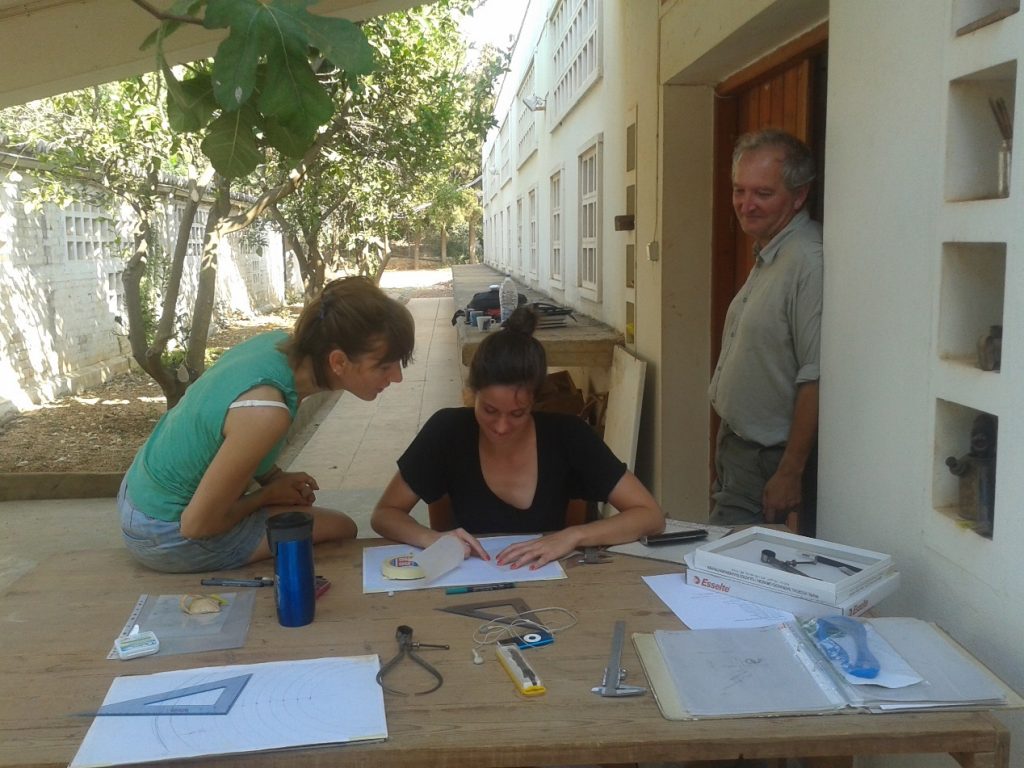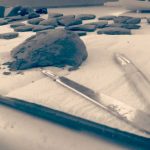Apothiki management and logistics
Since 2016, the new ‘Apothiki’ (or storerooms) of the Sissi Project located at Agios Nikolaos, East Crete, is operational. All the archaeological finds of seven excavation campaigns at Sissi have been gathered, transferred and reorganised within this new space, which also comprises spacious working areas facilitating the work of researchers and various specialists (conservators, draughstpersons, photographers, paleo-environmentalists, ceramic specialists, etc.). A new digital catalogue inventorying the more than 1400 storage crates has been created, providing easy access to the various and numerous data, as well as the precise location of every single archaeological find within the storeroom. This new setup of the Apothiki and the transfer of all the artefacts were organised by the Apothiki Manager Jenny Tsafou with the help of a Dimitris Kivernitakis and plenty of students.
Fig. 1a Organization of the new ‘apothiki’/storerooms at Aghios Nikolaos, under the direction of Evgenia Tsafou ©Sissi Project.

Fig. 1b Apothiki Dream Team, Sissi 2016; photo by Gavin McGuire © Sissi Project.

Fig. 2a Our draughtsperson, Hannah Joris, at work in our previous apothiki at the French School in Malia © Sissi Project.

Fig. 2b Photography of archaeological material by Chronis Nikolakopoulos, INSTAPEC photographer © Sissi Project.

Fig. 2c-d Management of the archaeological material with the assistance of Laura Mary and Roxane Dubois © Sissi Project.
Fig. 2c-d Management of the archaeological material with the assistance of Laura Mary and Roxane Dubois © Sissi Project.
During an excavation season, large quantities of artefacts and samples arrive at the Apothiki on a daily basis. Post-excavation treatment and the management of archaeological finds imply the initial cleaning of artefacts, its inventorying and documentation through photographing and drawing, but also sorting of pottery or soil samples, the consolidation and conservation of artefacts and the digitalization of all excavation data. These are everyday practices which occur during an excavation season, directed by several specialists helped in their tasks by a large number of students. During the off-season, the Apothiki facilities serve as an area of study and of processing of the numerous archaeological artefacts excavated. We now have properly arranged work spaces and equipped office space, which can host different kinds of specialists who study a variety of finds: pottery, human remains, faunal remains, plant remains, ichthyologic remains, lithics, small finds, etc. A conservation office has also been installed in order to enable conservators to provide the appropriate care to artefacts retrieved from the site.
Fig. 3a-b Conservation corner with conservators Pepi Saridaki and Constantina Hadjivasili © Sissi Project.
Fig. 4a-b Washing pottery every day, with the help of a large team of students © Sissi Project.
Fig. 5 Specialists working: ichytologist Rena Veropoulidou and seal specialist, Maria Anastasiadou
Evgenia Tsafou
Object Conservation
 The conservation of the Sissi Excavation Project’s moveable finds takes place at the Conservation Lab of the “Apothiki” of the Sissi Project but also at the fully equipped Conservation Laboratory of the Agios Nikolaos Museum, where we can occasionally work courtesy of the East Cretan Archaeological Service (see e.g. http://www.anatolh.com/2016/12/05/%CF%84%CE%B1-%CE%B5%CF%81%CE%B3%CE%B1%CF%83%CF%84%CE%AE%CF%81%CE%B9%CE%B1-%CF%83%CF%85%CE%BD%CF%84%CE%AE%CF%81%CE%B7%CF%83%CE%B7%CF%82-%CF%84%CE%BF%CF%85-%CE%BC%CE%BF%CF%85%CF%83%CE%B5%CE%AF%CE%BF/).
The conservation of the Sissi Excavation Project’s moveable finds takes place at the Conservation Lab of the “Apothiki” of the Sissi Project but also at the fully equipped Conservation Laboratory of the Agios Nikolaos Museum, where we can occasionally work courtesy of the East Cretan Archaeological Service (see e.g. http://www.anatolh.com/2016/12/05/%CF%84%CE%B1-%CE%B5%CF%81%CE%B3%CE%B1%CF%83%CF%84%CE%AE%CF%81%CE%B9%CE%B1-%CF%83%CF%85%CE%BD%CF%84%CE%AE%CF%81%CE%B7%CF%83%CE%B7%CF%82-%CF%84%CE%BF%CF%85-%CE%BC%CE%BF%CF%85%CF%83%CE%B5%CE%AF%CE%BF/).
The Sissi Project employs professional conservators to manage the care and the preservation of the finds, choosing methods of “minimal intervention” and reversible treatments, whenever this is possible. Most of the moveable objects that reach the conservation table are ceramics but a fair number of metal and stone objects is also treated.
Initially, an examination of the object is carried out, in order to evaluate its state of preservation, to understand and address the needs of the object. The condition of each object is recorded in writing and by photographs, both before and after treatment. The intervention normally includes cleaning, stabilisation, structural treatment and aesthetic reintegration.
1. Ceramics Conservation

Fig. 1: MM IIB straight-sided up before and after cleaning © Sissi Project.
Cleaning may be mechanical (dentist tools, scalpels, etc.) or chemical (solvents, solutions, light acids)
Consolidation with acrylic and synthetic resins.
Mending with acrylic resins and nitrocellulose adhesives
Gap-filling with plaster of Paris
Retouching with water-soluble pigments.
2. Metal Conservation
All metal treatments are performed under stereomicroscope and magnifying glass, at the Conservation Laboratory of the Ayios Nikolaos Museum.

Fig. 2: Bronze chisel before and after conservation © Sissi Project.
Cleaning is usually mechanical (needle, scalpel, glass fibre eraser) or chemical (solvents, solutions, acids)
Stabilization of the corrosion is followed by the application of a corrosion inhibitor product. For bronze objects, which constitute the majority of the metal finds, a 3% benzotriazole (BTA) solution in ethanol is used. All humidity is removed by heat and then a light solution of an acrylic resin is applied on the surface (Paraloid B72 10%/ acetone).

Fig. 3: Gaps in lead vase, filled with Glass Microballons/ 30% Paraloid B72 © Sissi Project.
For gap-filling, a paste of glass microballons and 30% Paraloid B72/acetone is used, materials suitable for metals.
Retouching can be achieved either by adding pigments to the filling paste or paint over the filled part after it dries.
3. Stone Objects conservation
Cleaning is done by washing in deionized water using soft brushes for the removal of soil. Salt crusts are softened with swabs of deionized water and then removed mechanically.

Fig. 4: Bird nest bowl before and after conservation © Sissi Project.
Consolidation with acrylic resin Paraloid B72/Acetone. Concentrations vary according to porosity and fragility of the stone, between 5% – 15% weight/vol. The solution is applied with a syringe on the surface and it is absorbed into the micro-cracks.Mending with acrylic resins.Filling with plaster of Paris.Retouching either with addition of pigments to the filling poultice or paint on the surface after it dries.

Fig. 5: Metal objects supported in polyethynene foam (Ethafoam) and packed in plastic boxes © Sissi Project
4. Storage and preservation
In order to achieve the essential long-term preservation of archaeological objects, these are provided with the best possible environmental conditions, sufficient security, appropriate packing and support materials.
Pepi Saridaki









